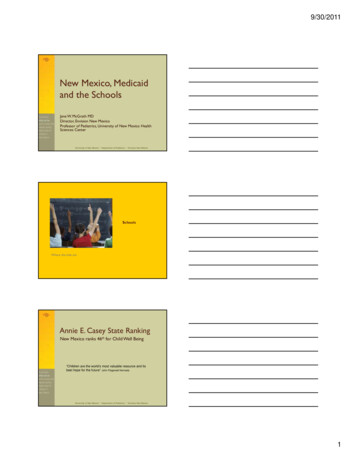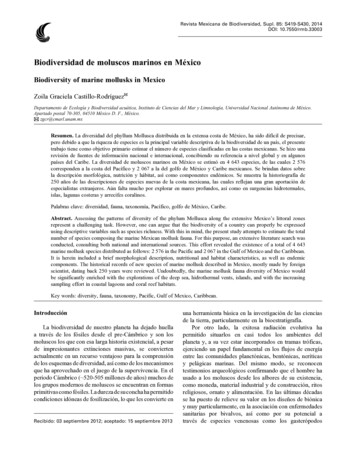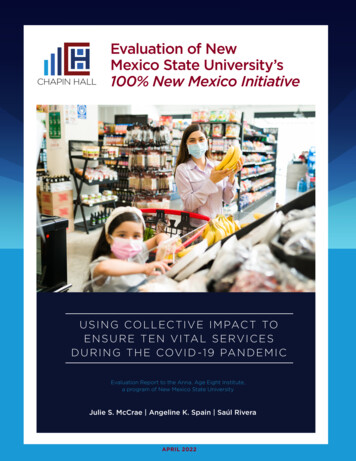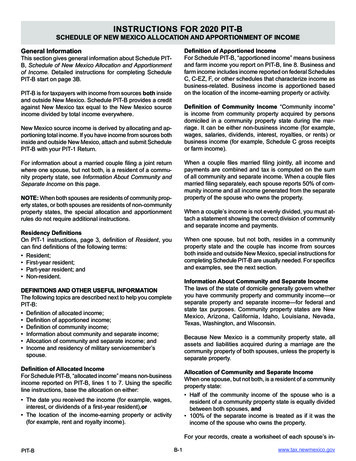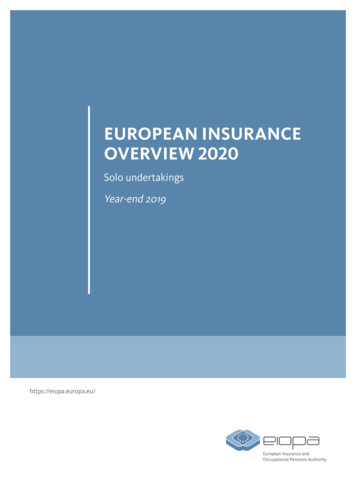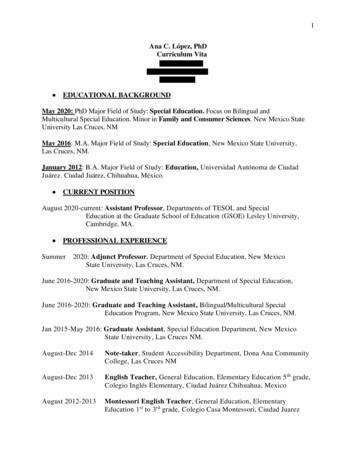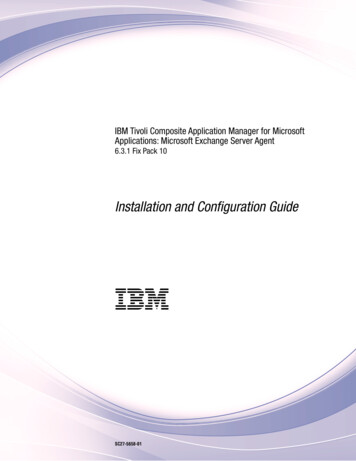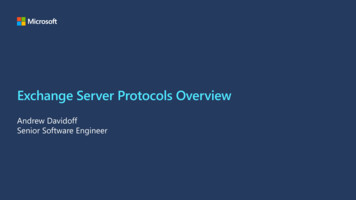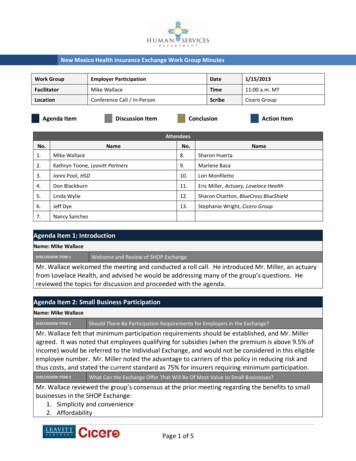
Transcription
New Mexico Health Insurance Exchange Work Group MinutesWork GroupEmployer ParticipationDate1/15/2013FacilitatorMike WallaceTime11:00 a.m. MTLocationConference Call / In-PersonScribeCicero GroupAgenda ItemDiscussion ItemConclusionAction ItemAttendeesNo.NameNo.Name1.Mike Wallace8.Sharon Huerta2.Kathryn Toone, Leavitt Partners9.Marlene Baca3.Jonni Pool, HSD10.Lori Monfiletto4.Don Blackburn11.Eric Miller, Actuary, Lovelace Health5.Linda Wylie12.Sharon Charlton, BlueCross BlueShield6.Jeff Dye13.Stephanie Wright, Cicero Group7.Nancy SanchezAgenda Item 1: IntroductionName: Mike WallaceDISCUSSION ITEM 1Welcome and Review of SHOP ExchangeMr. Wallace welcomed the meeting and conducted a roll call. He introduced Mr. Miller, an actuaryfrom Lovelace Health, and advised he would be addressing many of the group’s questions. Hereviewed the topics for discussion and proceeded with the agenda.Agenda Item 2: Small Business ParticipationName: Mike WallaceDISCUSSION ITEM 1Should There Be Participation Requirements for Employers in the Exchange?Mr. Wallace felt that minimum participation requirements should be established, and Mr. Milleragreed. It was noted that employees qualifying for subsidies (when the premium is above 9.5% ofincome) would be referred to the Individual Exchange, and would not be considered in this eligibleemployee number. Mr. Miller noted the advantage to carriers of this policy in reducing risk andthus costs, and stated the current standard as 75% for insurers requiring minimum participation.DISCUSSION ITEM 2What Can the Exchange Offer That Will Be Of Most Value to Small Businesses?Mr. Wallace reviewed the group’s consensus at the prior meeting regarding the benefits to smallbusinesses in the SHOP Exchange:1. Simplicity and convenience2. AffordabilityPage 1 of 5
New Mexico Health Insurance Exchange Work Group Minutes3. Education for both employees and employersDISCUSSION ITEM 3Should the Definition of Small Business be Increased from 2-50 to 100 Prior to 2016?Mr. Wallace reviewed the state’s current definition of “small business” as 2-50 employees, and thepending federal definition of 1-100 employees (not counting owner or owner’s spouse) that willapply after 2016. He listed the pros and cons, as determined in the Work Group’s prior discussion,of adopting the higher standard at Exchange implementation in 2014:Advantages:1. Larger risk pool2. Tax penalties motivating higher enrollment3. Increase in locations where Exchange plans can be purchased and a possible increase in thenumber of plans available for purchase4. Increased plan portabilityDisadvantages:1. Additional complexity2. More groups affected3. Statutory change/possible legislative involvementThe group briefly discussed possible pending legislation in this regard, and acknowledged that ifsuch a bill passes, their recommendation is not relevant. Mr. Wallace invited Mr. Miller to addressthe members regarding the potential early change in policy.Mr. Wallace felt that any policy that creates additional complexity and/or risk would have anunfavorable effect on insurance carriers. He felt the amount of disruption that will take place withExchange implementation will make the increased uncertainty of an early change undesirable. Thatsaid, he felt that an eventual change in this regard would be well-accepted by carriers, so long asthe market is given time to adjust to changes at a reasonable pace.Mr. Miller also believed that initial PPACA tax penalties will be an insignificant motivator for smallbusinesses to participate in the Exchange. He said that many employers of up to 100 employees arecurrently designated as large employers for insurance purposes, and instituting the broaderdefinition at Exchange implementation will mean they move from large to small employer status,which might be a disincentive to join.Ms. Wylie pointed out what she saw as a misdirected focus, stressing profits over quality ofcoverage for the neediest individuals. She described the plight of long-term care workers whofrequently work part-time without benefits, and the pending rise in patient load with theanticipated Medicaid expansion. Mr. Wallace responded that a Navigator would be able to helpthese employees locate the appropriate coverage within the Exchange.Page 2 of 5
New Mexico Health Insurance Exchange Work Group MinutesDISCUSSION ITEM 4How Can Adverse Selection in the SHOP Exchange Be Minimized?Mr. Wallace invited Mr. Miller to present a discussion on minimizing adverse selection within theExchange. Mr. Miller described how limiting consumer choices tends to control and decrease carrierrisk, assisting carriers in setting rates and ultimately controlling costs for the consumer. He led themembers in an examination of the balance between controlling risk and cost, and providingmaximum consumer choice while still encouraging the market.The Work Group discussed in detail the elements that create a healthy or adverse insuranceenvironment, including actuarial values, metallic levels, demographics and cost. Mr. Millerexplained that for carriers, current industry trends tend towards increased choices proportionate tothe size of the covered group (e.g., one choice for 1-10 employees, two for groups of 11-25, etc.).Bronze level plans were discussed as catastrophic coverage, which meet minimum standards ofcoverage at the lowest premium cost. Mr. Miller informed participants that only the poorest andhealthiest members of the population tend to choose this level of coverage. He felt that employersshould not be allowed to offer only this level of coverage.Mr. Miller promoted the 75% minimum participation requirement and at least a silver level ofcoverage minimum, as steps to be promoted in reducing adverse selection. Mr. Wallace felt thatthis was a decision that should be left to the Division of Insurance (DOI). Ms. Sanchez pointed outthat minimum participation requirements imply that many employers must offer the products of asingle carrier to be compliant with the percentage of enrolled employees. Mr. Miller said thatemployee choice is not necessarily curtailed if employers wish to choose more than one carrier, butrates will rise correspondingly.Ms. Toone asked whether risk adjustment might be done on the backend among carriers tocompensate for the rise in costs, and it was explained that only upfront adjustments are planned.Mr. Wallace described how risk adjustment is expected to play a part in lowering rates but notcompensate entirely.DISCUSSION ITEM 5Should Insurers be Required to Offer the Same Plans in Both the SHOP and Individual Exchanges?In order to maximize plan portability, prior group consensus had leaned towards insurance carriersbeing required to offer identical plans in both the SHOP and Individual Exchanges. Mr. Wallaceexplained that this option will allow employees to move from job to job, or from the SHOPExchange to the Individual, without interruptions in coverage.Mr. Miller, however, felt that identical pricing will not be a realistic option in this scenario, and thatsuch a policy will curtail creativity by carriers to offer products appropriate for each market. Hebelieves there will be resistance in the industry to such a policy.Page 3 of 5
New Mexico Health Insurance Exchange Work Group MinutesMr. Miller said that while some practices allowing ease of transition might be built into the system,there should be carrier leeway to offer products tailored and priced to meet the needs of eachmarket setting. He used as an example the tax subsidy scenario, where an employee may choose tomove to the Individual Exchange to take advantage of subsidies, but perhaps the plan sold in theSHOP Exchange may not qualify for these subsidies. He said that offering competitive products willsufficiently motivate carriers to create plans attractive to consumers.Agenda Item 3: Defined ContributionName: Mike WallaceDISCUSSION ITEM 1Will Implementing a Defined Contribution Model Attract Employers Who Currently Do NotOffer Insurance?In previous discussions, the Work Group had felt that defined contributions will be a strongincentive for employers not currently offering insurance to join the Exchange. Advantages discussedare as follows:1. Budgeting and administrative simplicity2. Increased choice3. Plan portability4. Increased enrollment resulting in lowered riskMr. Wallace asked Mr. Miller to explain the actuarial opinion of defined contributions. Mr. Millerfelt that from an underwriting perspective, the value of the policy depends upon the model theemployer chooses. Should an employer choose to limit available plans (e.g., a variety of plans by asingle carrier, then it does not adversely affect carrier risk). He said that when an employer offersreimbursement towards a specific metal level with the employee free to choose a higher metal levelplan out-of-pocket, frequently the higher costs involved motivate consumers to be more motivatedtowards responsible health choices, also limiting risk.Mr. Miller continued, saying that in general, the smaller the group, the more limited the choicesshould be, from a risk-management point of view. He discounted the theory, for the small businessat least, that defined contributions will necessarily contribute to increased consumer choice.DISCUSSION ITEM 2Is There Sufficient Demand To Achieve Plan Portability?Mr. Wallace felt that this was an underwriting question for which the group did not have sufficientinformation. He deferred to Ms. Toone for the specifics. She described plan portability, and agreedthat it was a difficult question. Mr. Miller said that in the case of two employers offering the sameplans with the same carrier, it might be a realistic option.DISCUSSION ITEM 3Is There Value in Premium Aggregation for Small Employers in the State?Mr. Wallace conceded that premium aggregation would be an advantage to employers, but askedthe group to consider whether premium aggregation should be done by carriers, employers or theExchange. Ms. Toone clarified that premium aggregation, in the sense of billing aggregation, was anPage 4 of 5
New Mexico Health Insurance Exchange Work Group Minutesoption that was required of the Exchange.Mr. Miller said that the ability to aggregate premiums was an option already offered by manycarriers as well. He noted that carriers will also be billed by the Exchange for their premiumaggregation services. He expressed dissatisfaction with the added costs, and said that paying boththe Exchange to administer the benefit and doing it in-house for other parties (e.g., off-Exchangeplans) would increase the administrative burden on carriers. Members ultimately determined thatthe Exchange should encourage whichever administrative option proves most cost-effective.CONCLUSION:Name: Mike WallaceMr. Wallace indicated that he would be forwarding copies of the minutes from this meeting to thegroup. He reminded members that the next 2 meetings would be devoted to the formation ofofficial recommendations. He notified participants of the date of the next scheduled meeting onJanuary 29th. He then thanked Mr. Miller for his assistance, and Mr. Miller invited the Work Group tocontact him should they have any further questions.Ms. Pool then reminded attendees to approve minutes from the prior meeting. Mr. Wallace solicitedvotes from members previously in attendance, and voting was unanimous in favor of approval. Hethanked the group for their participation and dismissed the meeting.Page 5 of 5
New Mexico Health Insurance Exchange Work Group Minutes Page 1 of 5 Work Group Employer Participation Date 1/15/2013 . Eric Miller, Actuary, Lovelace Health 5. Linda Wylie 12. Sharon Charlton, BlueCross BlueShield 6. Jeff Dye 13. Stephanie Wright, Cicero Group 7. Nancy Sanchez Agenda Item 1: Introduction Name: Mike Wallace DISCUSSION ITEM 1

